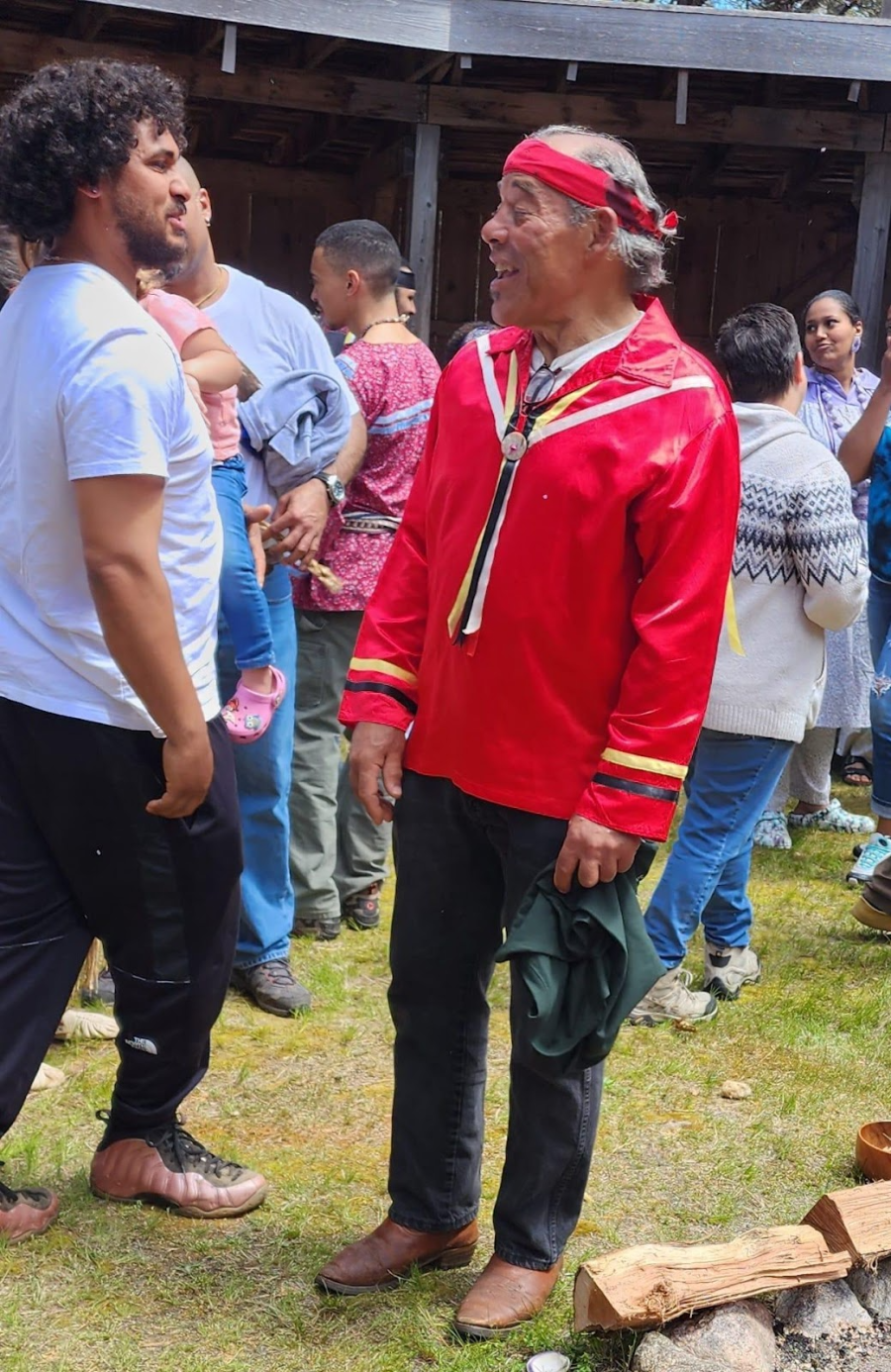Modern Hawai'i, like its colonial overlord, the United States of America, is a settler society. Our Hawaiian people, now but a remnant of the nearly one million Natives present at contact with the West in the 18th century, live at the margins of our island society. Less than 20% of the current population in Hawai'i, our Native people have suffered all the familiar horrors of contact: massive depopulation, landlessness, christianization, economic and political marginalization, institutionalization in the military and the prisons, poor health and educational profiles, increasing diaspora.
When the United States military invaded our archipelago in 1893 and overthrew our constitutional monarchy, our fate as an outpost of the American empire was sealed. Entering the U.S. as a Territory in 1900, our country became a white planter outpost, providing missionary-descended sugar barons in the islands and imperialist Americans on the continent with a military watering hole in the Pacific.
Today, Hawaiians continue to suffer the effects of haole (white) colonization. Our language was banned in 1896, resulting in several generations of Hawaiians, including myself, whose only language is English. Our lands and waters have been taken for military bases, resorts, urbanization and plantation agriculture.
Under foreign control, we have been overrun by settlers: missionaries and capitalists, adventurers and, of course, hordes of tourists, nearly seven million by 1998.
The latest affliction of corporate tourism has meant a particularly insidious form of cultural prostitution. The hula, for example, an ancient form of dance with deep spiritual meaning, has been made ornamental, a form of exotica for the gaping tourist. Far from encouraging a cultural revival, as tourist industry apologists contend, tourism has appropriated and cheapened our dance, music, language, and people, particularly our women. Burdened with commodification of our culture and exploitation of our people, Hawaiians now exist in an occupied country whose hostage people are forced to witness, and for many of us to participate in, our collective humiliation as tourist artifacts for the world's rich.
In the meantime, shiploads and planeloads of American military forces continue to pass through Hawai'i on their way to imperialist wars in Asia and elsewhere. Throughout the Second World War, Hawai'i was under martial law for seven years, during which time hundreds of thousands of acres of land were confiscated, civil rights were held in abeyance, and a general atmosphere of military intimidation reigned.
Now, caught in a political system where we have no separate legal status - unlike other Native peoples controlled by the United States- we are by every measure the most oppressed people living in our ancestral homeland.
THE RISE OF RESISTANCE
Between annexation in 1900 and statehood in 1959, haole sugar capitalists controlled the economy and the politics of Hawai'i. After Hawai'i became a state, however, the politics and demographics of Hawai'i shifted: Asian plantation workers, with a small group of Hawaiians, captured elected offices, including the governorship.
Statehood transformed Hawai'i's economy from a sugar/military outpost of an empire to a tourist/military outpost. Residential and commercial (predominently hotel) development encroached on lands once covered with sugar cane. New immigrants from Asia, especially the Philippines, poured into Hawai'i to work in the huge resorts, while tourists began to visit in the millions.
By 1970, rural Hawaiian communities were besieged by rapid development. Urbanization brought an influx of rich haole from the American continent who, unlike tourists, wanted to live in Hawai'i. Evictions of Hawaiians lead to increasing protest, especially in communities scheduled for residential and commercial development.
An early and typical example here was the Kalama Valley eviction on O'ahu island in 1970. Rural Hawaiians living by month-to-month leases on lands controlled by one of the largest private trusts in Hawai'i, the Bishop Estate, were given one month's notice to leave their homes and farms of more than twenty years. The residents' resistance called forth an outpouring of support throughout the archipelago. Although the residents failed to stop their eviction and the transformation of their pig and vegetable farms into upper-income developments, the resistance began to spread to every island.
By 1976, Hawaiians were landing on Kaho'olawe Island to protest its use as a military bombing range since the second World War. Kaho'olawe is home to many navigational and other ancient Native sites. After the death of two activists, and the arrests and jailing of many more, the bombing was finally halted in 1990. Although this was a clear victory for the Native people, the military has not lost major ground in Hawai'i.
The decade of the 1980s witnessed enormous growth in political and cultural resistance on the part of Native Hawaiians. Mass demonstrations, legal actions, and cultural assertions, like the building of beach villages or the occupation of sacred areas, continued. In addition, local and federal legislation designated monies for Hawaiian communities, or for programs like education and health, in an obvious effort at pacification.
Still, the merging of land-rich but capital-poor landowners with out-of-state corporations continued to be a familiar pattern. Large resorts, replete with golf courses and restaurants, sprang up near beaches, in valleys, and on conservation lands. Missionary landowners linked up with American and Japanese multinational corporations to develop the most beautiful areas on all the major islands.
As Hawaiians protested commercial development, they also began organizing to reclaim a land base. Land taken from the Hawaiian government at the overthrow - nearly two million acres - and lands awarded in compensation for military or other takings became the focus of intense organizing. Legal entities, political groups, and community coalitions called for some kind of reparation from the United States for its role in the overthrow of the Native government in 1893, and forced annexation in 1898.
The example of the "trust" lands is a good case study of the subjugation of Native Hawaiians. The American Congress allotted nearly 200,000 acres of the poorest agricultural lands to Native Hawaiians under the Hawaiian Homes Commission Act of 1921. Ostensibly for farm and residential use, the lands are marginal, situated in inaccessible areas, and undeveloped. Additionally, no monies were allocated to improve the lands.
Since its creation, the Hawaiian Homes trust has been administered first by the Territory of Hawai'i and then, in 1959, by the state of Hawai'i. Allegedly, the federal government has had oversight responsibility for the trust since its inception. In practice, however, the trust lands have been a readily available pool for every use but that stipulated in the Act.
These illegal uses now include airports, military reservations, public schools, public parks, even private homes and county refuse dumps. While these illegal uses continue, so too has the rise of legitimate applications for lots. By 1999, the waiting list for pastoral and residential lots on the islands of O'ahu, Maui, Hawai'i, Kaua'i, and Moloka'i totaled over 29,000 applicants. Meanwhile, illegal and other non-Native uses continue on more than 130,000 of the allotted 200,000 acres.
Obviously, the state of Hawai'i and the federal government are active agents in continued alienation of Hawaiian natural resources, abuses of Native civil and human rights, and denial of economic and political self-determination.
As in the case of the trust lands, military expropriation of Native lands, and the abuse of such lands for bombing, troop maneuvers, and other destructive actions, has also become a focus of intense protest. The American military controls over 30% of the most populated island of O'ahu, and other large land areas on the islands of Hawai'i, Maui, and Kaua'i.
By the mid-1990s, the Hawaiian protest movement had affected every economic and political concern in the state of Hawai'i. Dozens of Hawaiian groups had raised awareness of issues like the abuses of the trust lands, beach access and community control, and the horrible state of Hawaiian health, including categories like infant mortality, obesity, and cancer.
Cultural practitioners of our traditional dance, called hula, also entered the movement. Traditional dance had been suppressed as a result of Christian missionizing in the 19th century, the American overthrow of our Native Queen, and the banning of the Hawaiian language in 1898. After statehood and the passing of four generations, however, the hula experienced a revival. Encouraged because of the state's increasing dependence on the visitor industry, hula h...lau (dance academies) proliferated in the seventies. These h...lau became a springboard for new organizations that came to serve, in the nineties, as building blocks for political activity.
Today, hula h...lau have evolved into sites of both cultural and political resistance. When the Hawai'i legislature sought to pass legislation in 1998 preventing gathering of vines and flowers used for adornment in the hula, more than 1,000 Hawaiians demonstrated against the bill. Predictably, legislators had been encouraged to submit the bill by a group recently arrived from California whose stated purpose was the protection of private property. Apart from the clash between American individualistic values and Native communal use values, the legislative effort to prevent the gathering rights of hula h...lau had the unintended effect of further uniting cultural groups, thereby increasing the strength of cultural resistance.
Out of this unity was born a coalition of hula h...lau numbering over 1,500 members, called `...lio'ulaokalani. Founded in 1997, over 20 years after the birth of the Protect Kaho'olawe 'Ohana, the `...lio Coalition publicly challenged the bill through a 24-hour mass rally at the opening of the state legislature. When this bill was defeated, the power of Hawaiian resistance in the political arena was enhanced along with the value of community organizing.
Finally, with the creation of various land rights groups, Hawaiians began to coalesce around the issue of sovereignty. A state agency, the Office of Hawaiian Affairs (OHA), had been created by a state Constitutional Convention in 1978. In the first several years, the Office was content to work on reparations from the American government for the overthrow in 1893. But OHA was surpassed by intense, grassroots resistance in Hawaiian communities.
From this outpouring of political and cultural activity came a Native initiative for sovereignty called Ka L...hui Hawai'i. Founded in 1987 with a constitutional convention, Ka L...hui enrolled thousands of citizens. They organized themselves as a kind of government in exile, with a constitution, elected representatives, and a master plan for the future. Today, the goal of Ka L...hui remains one of inclusion in the Federal American policy on recognized Native nations.
For all the current sovereignty initiatives in Hawai'i, the definition of the term, "sovereignty," is simple: the ability of a people who share a common culture, religion, language, value system and land base, to exercise control over their lands and lives, independent of other nations.
The following articles by members of Ka L...hui address the history of Hawaiians, the impact of colonization on their health, lands, and culture, and the current sovereignty push, including human rights issues of burials, militarization, and corporate tourism.
Article copyright Cultural Survival, Inc.



